By Michael Lerg
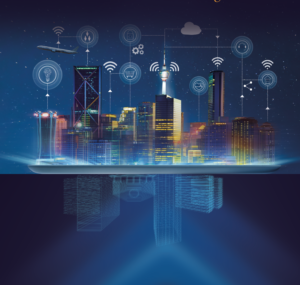
Advancing technologies are converging into a new tool for enhanced insights and decision-making capabilities that enable improved operational outcomes in many areas of a property. This article will explain how this tool, Smart Building Digital Twin, marries what have been two separate concepts into a much more powerful solution, and how it can benefit you and your clients.
Virtual replicas of buildings (Digital Twins) have been growing in use for the construction process and facilities management. Smart Buildings use real-time data gathered from building sensors (i.e., IoT – the internet of things) along with other data to improve property and facilities management. The power of these two tools is now being combined into a more powerful solution called Smart Building Digital Twins.
The consolidation of these capabilities into a single, unified solution can deliver a tremendous amount of information using 3D visualization that makes the data easier to consume and utilize. This results in significant improvements during the construction process and while operating a building. Benefits of employing a Smart Building Digital Twin can include shortened construction timelines, reduction in costly change orders, improved building operations resulting in lower operating costs and better tenant experiences. If constructed properly, a Smart Building Digital Twin can also help accelerate leasing or unit sales. Ultimately the result is a better performing asset that delivers higher investor returns.
Smart Buildings
The real estate industry has struggled to agree upon the definition of a Smart Building. While most buildings now incorporate at least some aspect of Smart technology, there exists no consensus as to what makes a building Smart. In general, Smart Buildings use on-site sensors to gather data to track and analyze metrics such as air quality, temperature, elevators, occupancy and electricity usage. This data, both current and historical, is then processed and analyzed using Artificial Intelligence (AI), Machine Learning (ML) and other software to create digital simulation models that update and change as their matching physical counterparts change. The integration of building automation provides improved occupant comfort, efficient operation of building systems, reduction in energy consumption, reduced operating and maintaining costs, increased security, historical performance documentation, remote access/control/operation, and improved life cycle of equipment and related utilities.
Key components of Smart Buildings include:
- Internet of Things (IoT) Sensors monitor the status of devices and the environment within and around the building, sending that information (data) through the internet to the Building Management or Automation Systems (BMS/BAS) for further action. Sensor technology has greatly advanced recently to include monitoring key elements within a Smart Building’s ecosystem which include:

- Building Management and Automation Systems not only monitor the IoT sensors and control smart devices within a building, they also provide centralized monitoring and control of a building’s HVAC (heating, ventilation, and air conditioning), electrical, lighting, shading, access control, security systems, elevator and other interrelated systems.
Digital Twins
A Digital Twin is a virtual representation designed to act as a real-time digital counterpart of a physical object or process. The concept of Digital Twins originated during the early days of space exploration. Faced with the challenge of operating, maintaining and repairing systems that were quite literally nowhere on Earth, NASA was the first to experiment with pairing physical assets to the virtual world. Below is a photo of the Apollo Simulators at Mission Control in Houston. The Lunar Module Simulator is in the foreground in green, and the Command Module Simulator is at the rear of the photo in brown (image courtesy of NASA).
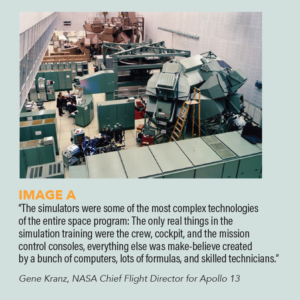
“The simulators were some of the most complex technologies of the entire space program: the only real things in the simulation training were the crew, cockpit, and the mission control consoles, everything else was make-believe created by a bunch of computers, lots of formulas, and skilled technicians”. Gene Kranz, NASA Chief Flight Director for Apollo 13
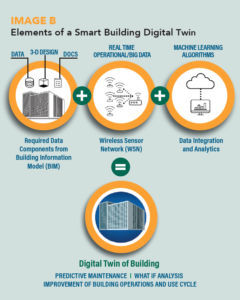
Fifty years since Apollo 13 and 20 years since the term “Digital Twin” was first coined, the use of Digital Twins is reaching a fevered pitch. This growth is being facilitated by vastly improved internet connectivity, sophisticated monitoring technologies and the prevalence of Virtual Reality (VR).
Key components of a simple Digital Twin include:
- Physical Object, Process or System
- 3D Virtual Object, Process or System, and
- Connections between them – known as Digital Threads
Smart Building Digital Twins
It then follows that a “Smart Building Digital Twin” combines “Smart Building” technologies with the capabilities of “Digital Twins” to provide building owners and operators the ability to maintain their assets more efficiently, improve performance, predictably reduce system failures, and save significant amounts of money through simulation and optimization. That is in addition to boosting the health and wellness of the building’s occupants.
The information provided by Smart Building Digital Twins can be categorized and visualized in four layers:
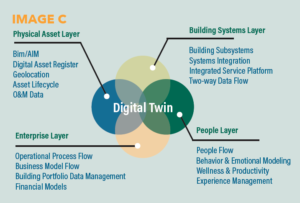
This information is often generated from disparate systems within the building. While this type of information is usually presented as a series of 2D charts, graphs and illustrations of the building, the Smart Building Digital Twin helps the user visualize this information using Extended Reality (XR), which includes Virtual Reality, Augmented Reality and Mixed Reality. These virtual technologies are critical to maximize the user’s true understanding of what’s happening within the building. One benefit of using XR to visualize a Smart Building Digital Twin is the ability to virtually see through walls, floors, and ceilings to:
- Visualize the infrastructure of the building
- Quickly find, identify and resolve maintenance issues
- Access all related information and documentation for any element in the building
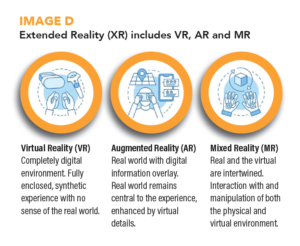
Operational data can be brought to life by being able to visualize the data and problems where they occur within a building. Occupancy data can potentially signal when a lease may be at an increased risk of non-renewal. Owner/operators may be able to act on the information to either help retain that lease or plan further ahead for turnover. Collected data can also be used to simulate events within the 3D virtual model. Building operators can use the simulation results to reduce risks and eliminate factors causing danger or deterioration.
If you own, operate or maintain a property, this technology should be on your radar. The growth rate for Digital Twin technology is accelerating rapidly; according to a new study by Grand View Research Inc., the global Digital Twin market is anticipated to reach $86.09 billion by 2028, and the residential and commercial real estate market is currently the largest segment at 20%.
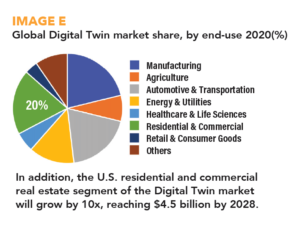
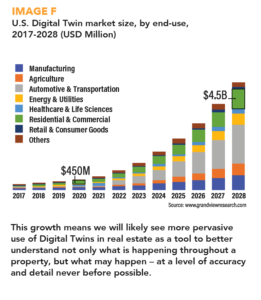
In addition, the US residential and commercial real estate segment of the Digital Twin market will grow by 10x, reaching $4.5 billion by 2028.
This growth means we will likely see more pervasive use of Digital Twins in real estate as a tool to better understand not only what’s happening throughout a property, but what may happen – at a level of accuracy and detail never before possible.
Summary
Smart Building Digital Twins integrate data from Smart Buildings (BIM, IoT Sensors, Building Management and Automation Systems) as well as Digital Twins (3D Virtual Model, Data Integration and Simulation). They can then process that data with AI, ML and other analytic tools to provide actionable intelligence about any aspect of the building as well as its systems, sensors and occupants. XR (in the form of VR, AR or MR) provides a naturally intuitive means to visualize and understand all of the subtle implications presented by Smart Building Digital Twins. These technologies provide key decision-makers with the information they need, along with intelligent recommendations, to optimize the building’s performance, lower maintenance and energy costs and troubleshoot ‘what-if’ scenarios. As a result, new business models and market offerings will emerge, and the way spaces are designed and built will be redefined. Buildings will become more intuitive, able to better accommodate human sensitivity and have the capacity to nurture the rich ecosystems they contain. It will no longer be sufficient to simply design, build and lease a space, but to make it think.
Once digital twins reach a critical mass, then Smart Cities will become the norm, providing unlimited capabilities in terms of city and regional planning, efficiencies in infrastructure and optimized traffic patterns just to name a few.
“Digital Twins will become the ultimate tool for city governments to design, plan and manage their connected infrastructure and assets in an efficient and cost-effective way, achieving $280 billion in cost-savings by 2030” said Dominique Bonte, vice president end markets at ABI Research.
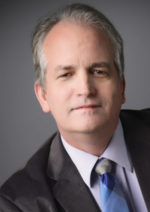
Michael Lerg
Michael Lerg is the CTO of Pix and has over thirty years of experience leading the development of Custom Visualization, Simulation, and Training applications – specializing in numerous forms of Virtual Reality and Augmented Reality. He began creating computer-based photorealistic Architectural Visualizations and Simulations in the mid-80’s including but not limited to studies of various large corporate campus and high-rise zoning requirements, sun studies, and lines of sight from neighboring properties. His personal strengths afford him the ability to accurately and rapidly capture the needs of the client, compare and analyze available technologies, develop project specifications and actions required by the artists, developers, and other team members to deliver uniquely specific user experiences that exceed the client’s expectations while maintaining each project’s budget, timeline, and high quality of customer service.
Michael holds a B-Arch degree from California Polytechnic State University, San Luis Obispo. You can reach him at: (281) 299-3159 or MLerg@Pix-Virtual.com.
Featured in Harrisburg Commercial Real Estate Review – 3rd/4th Quarter

